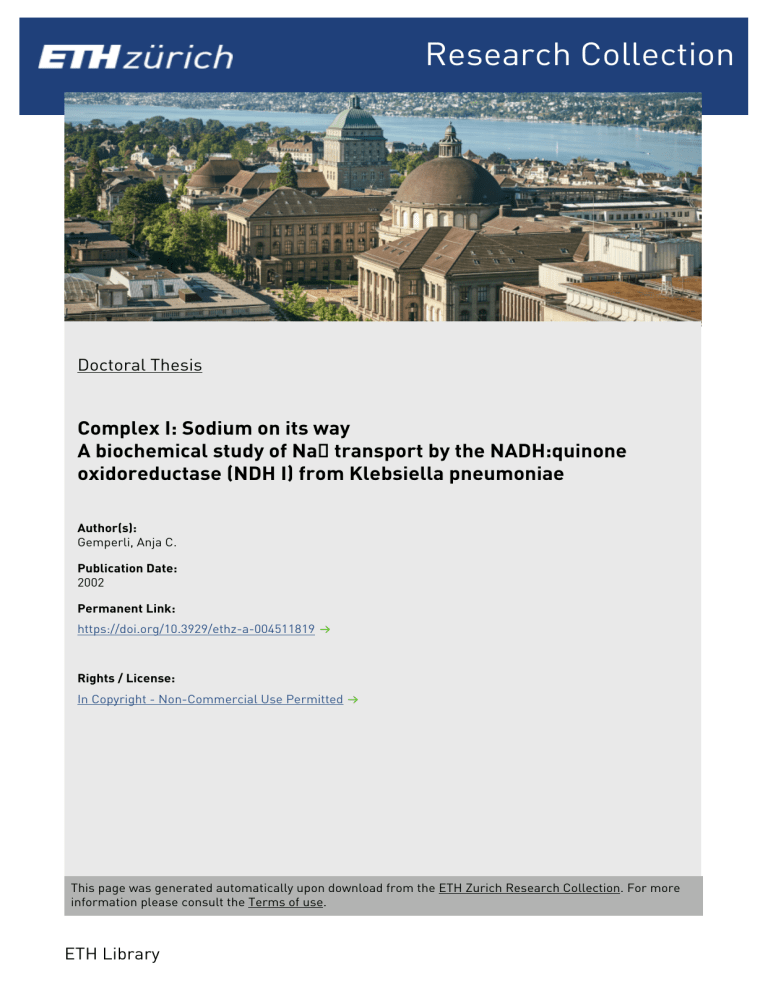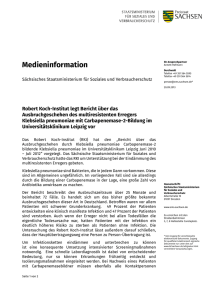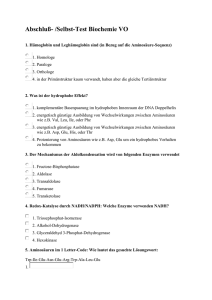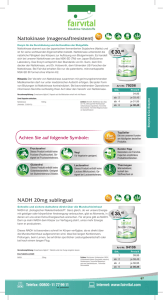Sodium on its way A biochemical study of Na transport by the NADH
Werbung

Research Collection Doctoral Thesis Complex I: Sodium on its way A biochemical study of Na� transport by the NADH:quinone oxidoreductase (NDH I) from Klebsiella pneumoniae Author(s): Gemperli, Anja C. Publication Date: 2002 Permanent Link: https://doi.org/10.3929/ethz-a-004511819 Rights / License: In Copyright - Non-Commercial Use Permitted This page was generated automatically upon download from the ETH Zurich Research Collection. For more information please consult the Terms of use. ETH Library Diss. ETH No. 14885 Complex I: Sodium on its way A biochemical study of Na+ transport by the NADH:quinone oxidoreductase (NDH I) from Klebsiella pneumoniae A dissertation submitted to the SWISS FEDERAL INSTITUTE OF TECHNOLOGY ZÜRICH for the degree of DOCTOR OF NATURAL SCIENCES presented by ANJA C. GEMPERLI Dipl. chem. ETH Zürich born February 22, 1972 from Mogelsberg (SG) accepted on the recommendation of Prof. Dr. P. Dimroth, examiner Prof. Dr. L. Thöny-Meyer, co-examiner Dr. J. Fritz-Steuber, co-examiner Zürich 2002 Zusammenfassung 1 Zusammenfassung Die elektrogene NADH:Chinon Oxidoreduktase aus Klebsiella pneumoniae pumpt Na+ Ionen. Die spezifische Na+ Transportaktivität des Enzyms in Membranen konnte durch anaerobe Reinigung von 0.2 µmol min-1 mg-1 auf 4.7 µmol min-1 mg-1 nach Rekonstitution in Liposomen erhöht werden. Die prosthetischen Gruppen von Komplex I, (Eisen-Schwefel-Cluster und FMN) wurden im gereinigten Protein zu 50-70 % der erwarteten Werte angereichert. Des Weiteren konnten erstmals 2 zusätzliche Chinone, Ubichinon 6 und Ubichinon 8, als Kofaktoren in einem bakteriellen Komplex I identifiziert werden. Die chemische (NADH Oxidation/Chinon Reduktion) und die vektorielle (Na+ Transport) Reaktion des Enzyms war strikt gekoppelt, da Chinon in Abwesenheit von Na+ Ionen nicht reduziert wurde. Die Aktivierung von Komplex I durch Na+ Ionen konnte durch die Hill Gleichung beschrieben werden. Daraus wurde der Hill Koeffizient von 1.96 und eine halbmaximale Sättigung bei 330 µM Na+ berechnet. Der Quotient der Na+ Transport und Chinon-Reduktion Initialraten ergab eine Na+/e- Stöchiometrie von 1 für Komplex I von K. pneumoniae. Komplex I von K. pneumoniae und die ATP Synthase von Ilyobacter tartaricus konnten durch einen elektrochemischen Na+ Gradienten gekoppelt werden, wenn sie gemeinsam in Proteoliposomen rekonstituiert wurden. Dabei wurde der Na+ Gradient durch exergonen Elektronentransport (NADH → Q) von Komplex I aufgebaut und trieb die ATP Synthese an. Diese Reaktion konnte umgekehrt werden (rückläufiger Elektronentransport) wenn die Triebkraft der ATP Hydrolyse die Energie für die Reduktion von NADH mit Chinol lieferte. Das Membranpotential war unabdingbar für den rückläufigen Elektronentransfer, wohingegen der chemische Na+ Konzentrationsgradient die NAD Reduktion zwar beschleunigte, aber nicht zwingend nötig war. Komplex I zeigte keine Protonentransport-Aktivität. 2 Summary Summary The electrogenic NADH:quinone oxidoreductase from Klebsiella pneumoniae transports Na+ ions. After anaerobic purification and characterization the oxidoreductase was identified as complex I (NDH I) from Klebsiella pneumoniae. NADH-driven Na+ transport catalyzed by complex I increased more than 23-fold (4.7 µmol min-1 mg-1) compared to Na+ translocation into native membrane vesicles (0.2 µmol min-1 mg-1). Complex I was found to contain approximately 50-70% of the expected cofactors (Fe, acid labile sulfur and FMN) which increased during purification in correlation with Na+ transport activity. In addition, the purified complex I from K. pneumoniae was found to contain quinones, namely Q6 and Q8, which had not been identified previously in bacterial complex I. The reduction of Q by NADH was strictly Na+ -dependent which indicated coupling of the chemical and the vectorial reaction of the pump. The Na+ activation profile corresponded to the Hill equation with a Hill coefficient KH(Na+) = 1.96 and with a half maximal saturation at 0.33 mM Na+. Comparing the initial rates of Na+ transport and Q1 reduction activities, a Na+/e- transport stoichiometry of 1 was calculated for complex I. Coreconstitution of purified complex I from K. pneumoniae and the Na+ -translocating F1F0 ATPase from Ilyobacter tartaricus resulted in the coupling of the two enzymes via an electrochemical Na+ gradient. A sodium cycle could be established driving the synthesis of ATP in the course of NADH oxidation (forward electron transfer) or ATP-driven NAD reduction with ubiquinol (reverse electron transfer). A transmembrane voltage (∆Ψ) was shown to be obligatorily required for reverse electron transfer while the chemical Na+ concentration gradient (∆pNa+) accelerates NAD reduction by complex I, but was dispensable. Pumping of protons instead of or in addition to Na+ transport by complex I could be excluded.


